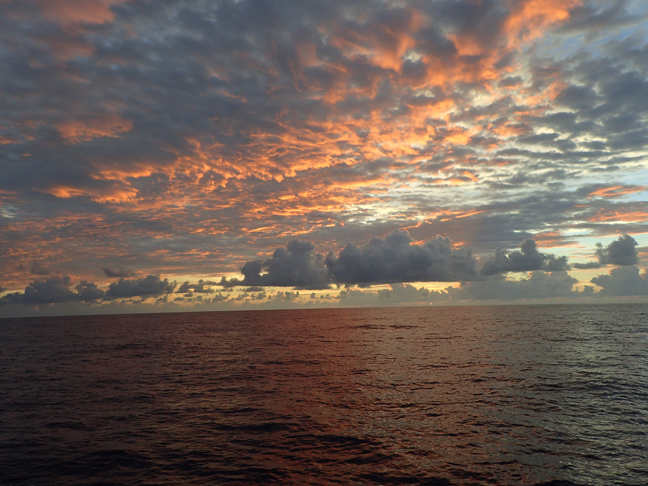
It is August 15th, and it has been 11 days since we dropped anchor at Nuku Hiva in the Marquesas Islands. Both Rod and Zack have left for the States to return to their day jobs, while my wonderful Francesca arrived just a couple of days ago. I’m so happy she is finally here, but also glad that she didn’t join us on the crossing as it was really a wild 19-day ride across the Pacific.
Not the crossing that I imagined
I had envisioned crystal clear skies and wonderful trade winds, but in reality the crossing was a real slog. We dodged hurricanes and tropical storms, and were smashed around most of the time. The boat pitched at such steep angles against the pounding and rolling waves, we had to lock ourselves in harnesses to avoid being thrown overboard. Even sleeping was a challenge. As the winds changed direction and speed, we were often jolted awake by Captain Bob’s signal for everybody to hop on deck to make sail adjustments.
Captain Bob pointed out that sailing south in the Pacific during this time of year, when tropical storms are suddenly being generated one after the other off the coast of Mexico, is “like a dog trying to cross a freeway,” and that’s what it felt like! I was grateful to have the crew that we did. Captain Bob, Els, Zack and Paul were all pros. Rod and I were the students, soaking in all the activities and learning as quickly as we could.
Even washing dishes was a challenge. I give Els huge accolades. She is not only a seasoned sailor, but a seasoned sailor who knows how to cook. Just watching her in the galley was a thing of beauty, preparing meals like clockwork: 7 a.m., 12 p.m. and 6 p.m. Zack expected to lose weight because of the rough seas, but he said he probably gained some because of El’s fantastic meals.
Would you do it again?
While sitting around the dinner table one night, I asked the crew if they would do the crossing again. In a heartbeat, Zack and Paul replied like the pro sailors they are, “Of course!” When Rod was asked the same question, he said, “Well, it was one of the wonderful experiences in my life. Would I want to do it again? I think I’m good for a while!” For me, I would say yes, but I would be extra careful in selecting a route with the most favorable wind and weather conditions.
Staying out of the path of hurricanes
During our sail south, staying away from adverse weather conditions was a big task. Navigation was not always easy, as the meteorological data and forecasts we received didn’t always line up with the actual conditions we encountered. I realized that with no land at risk from bad weather and so few sailors in these waters relying on accurate weather data, there is not much incentive for weather analysts to generate highly accurate wind and weather forecasts for this area of the Pacific. Good thing Captain Bob has a wealth of knowledge when it comes to how storms behave and a keen ability to interpret the conditions around us.
We made it through with the information we had and a lot of effort on everyone’s part. Zack also brought a wonderful tracking device that shared our location with loved ones back home, and it allowed us to communicate with short messages on our progress. When we finally got to the Marquesas, we breathed a collective sigh of relief (a big one), and we all sacked out for a couple of days just to regain our strength. (You’ll find highlights of the crossing in Double X: Photo Album 5.)
Anyone out there?
During the crossing we only saw three boats. Can you imagine traveling more than 3,000 miles at sea and seeing only a handful of boats? Without fish to attract fishing fleets and being below the Asia to North America container ship routes, just about the only possible ships we could encounter would be the giant iron ore bulk carriers taking material from South America to steel mills in Asia, and we saw one of those. When I say “saw,” I mean the sophisticated GPS system identified many miles in advance that we were on a near collision course with this ship so we notified the ship by radio and requested politely if they would slightly adjust course (its easier for a boat under engine power to do this than a sailboat) and they kindly altered course to stay several miles clear of us. Needless to say, it was very quiet out there.
With the bad weather, stargazing opportunities were somewhat limited. For most of the trip, the moon and stars were hidden behind the clouds, but when we did see them, it was truly a sight to behold as they appeared to extend to the horizon.
A digital detox
It was actually quite amazing to be in the middle of the ocean for 19 days. We didn’t see any planes and there was not a spec of land for 1,500 miles in either direction. Rod explained it best: It was like going through digital detox. We were cut off from email, news and almost all forms of modern communication. We were also cut off completely from pollution of any kind, and breathing fresh, pure air that had been circulating through the open ocean for thousands of miles. It was as if we were in a different dimension. It was a daily rhythm that required that we concentrate on what we were doing with no multi-tasking, a daily rhythm in which time seemed to stop or at least go very slowly.
Crossing the equator
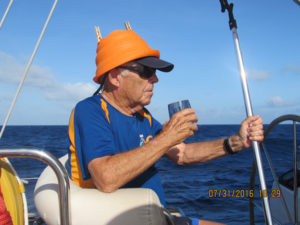
Sailing over the equator was one of the highlights of the crossing. Three crew members, Paul, Zack and Rod, had never crossed the equator by sail, so we had a special ceremony for these newbies (pollywogs) to join the ranks of the veterans (shellbacks).
I’ve crossed the equator once before by sailing and about 40 times by air. Bob and Els figured that they had crossed the equator by sea about 20 times, so they certainly win the prize for the most crossings by sailing. Whether a pollywog or a shellback, it’s always an exciting moment that’s worthy of celebration.
Channeling my inner King Neptune
I officiated over our equator-crossing ceremony as the official emissary of King Neptune, Ruler of the Sea. It’s a fun tradition of sailors. By this time—about two weeks from the start—we were getting pretty silly out there.
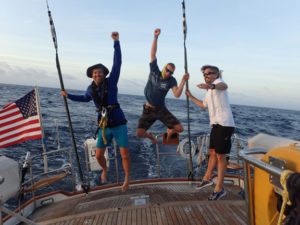
To become shellbacks, Paul, Zack and Rod had to present an offering of wine to yours truly and state their best case for why they should be permitted to cross the equator. Oh, and they had to tell their best joke. (They all passed with flying colors!)
I gave Zack the assignment of writing down a few jokes; here is one of my favorites:
| This is the actual transcript of a radio conversation between a British Navy ship and the Irish Coastguard, off the coast of Kerry:
Irish: Please divert your course 15 degrees to the south, to avoid collision British: Recommend you divert your course 15 degrees to the north, to avoid collision Irish: Negative. You will have to divert your course 15 degrees to the south to avoid collision. British: This is the Captain of a British Navy Ship. I say again, divert YOUR course. Irish: Negative. I say again, you will have to divert YOUR course British: THIS IS THE LARGEST SHIP IN THE BRITISH FLEET. WE ARE ACCOMPANIED BY 3 DESTROYERS, 3 CRUISERS, AND NUMEROUS SUPPORT SHIPS. I DEMAND THAT YOU CHANGE YOUR COURSE 15 DEGREES TO THE NORTH, OR COUNTERMEASURES WILL BE UNDERTAKEN TO ENSURE THE SAFETY OF THIS FLOTILLA. Irish: THIS IS A LIGHTHOUSE …. YOUR CALL! |
Nirvana?
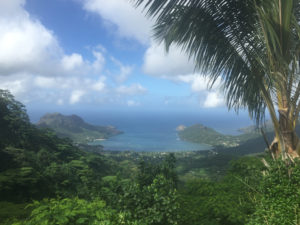
As mentioned earlier, we are now in Nuku Hiva. The beauty of the land is so spectacular that when people arrive they often proclaim, “Wow, this is paradise lost!” I have to agree. It really is a magical place. Green mountains soar straight from the blue sea to the sky, there is almost no development to speak of and the people are friendly and happy and decorated with amazing tatoos.
We posted a few photos in Double X Photo Album 6 that really capture the islands beauty. And, Zack and Paul took this amazing video during our tour of the back country:
The only pest on the island is the dreaded no-no (sand flies that are not only extremely bothersome, but also leave large welts).
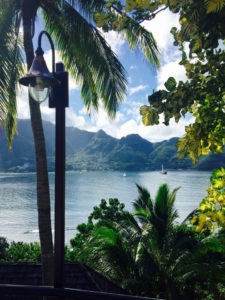
Even though Taiohae Bay at Nuku Hiva is the capital of the Marquesas, the pace is very slow with very few shops, restaurants or tourists. Fortunately, for reprovisioning the Double X, there are a couple of small supermarkets. There is a very weak cellular signal, and the one WiFi-enabled cafe had nice coffee, but an internet speed that reminded us of the early 1990s. There is no trash, traffic or violent crime. The few people in jail are there for growing or selling marijuana.
When you see all this beauty, you really have to tip your hats to the French government for subsidizing efforts to protect Nuku Hiva and the other five Marquesas Islands to preserve their natural beauty.
Next stop: Tuamotus
Soon our friends, John and Elise will be joining us in Rangiroa and then we’ll be spending a couple of weeks in Rangiroa, Fakarava and Ahi, three of the beautiful atolls in the Tuamotus. Elsie will go home, but hopefully, the sailing life agrees with John and we can entice him to join the crew. I’m keeping my fingers crossed. Till next time.
Cheers,
![]()
P.S. Don’t forget you can subscribe to our RSS feed to have blog posts delivered right to your inbox.
P.S.S. A quick update from the Land Crew: As of this post, Dr. Sam and the Double X crew have left the Marquesas Islands and are on the Tuamotu atoll of Fakarava. Dr. Sam says communication from the islands is like drinking from a small straw as information is transmitted in drips and drabs. We’ll keep you posted as updates come in on their upcoming adventures on Fakarava and beyond.

Amazing adventure! Happy to start following on your blog!
Love following your adventure Sam. So much fun knowing what’s going on and where you are. Can you send more photos’ of the gang? By-the-way your joke is hilarious…… Please tell more!
Sam,
I’m just loving your blogs. This is some adventure!! You are taking me to places I didn’t even know existed. I’m learning all about these places – the people, climate, lifestyle, existence, etc. Jackie and I have you tracked!! Great that Francesca is with you – glad she missed the choppy ride!
I’m sure you are looking forward to John and Elise joining you.
Keep your hand on the helm,
Best regards,
Gordon
Sam,
So impressed that you are living your dream and loving the adventure. Thanks for sharing with us. It’s been fun reading your blog posts. All the best!
Traveling with you vicariously is wonderful, and we aren’t seasick! Amazing sights. So appreciate this journal and pictures.
Jeanne & Scott
What a fantastic voyage. Thanks for sharing with all the landlubbers via text and pictures.
This is so awesome to follow the boat. What a wonderful experience for the crew and my nephew Paul!
So glad to see you’re back online. Pictures are amazing. Love reading all about your trip.